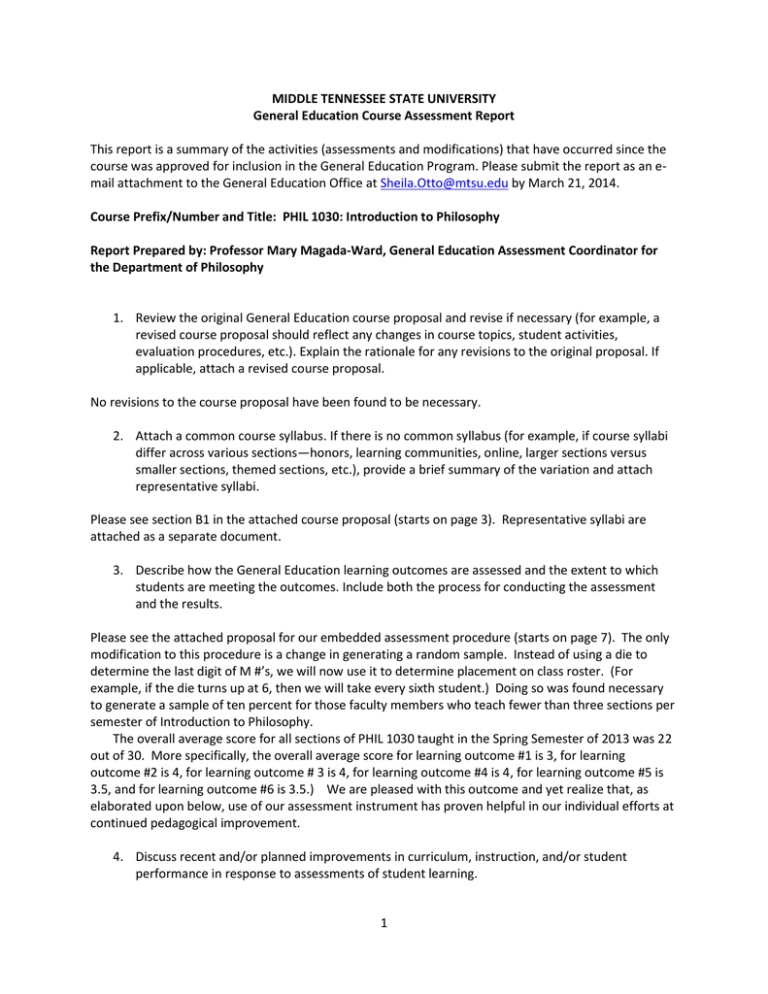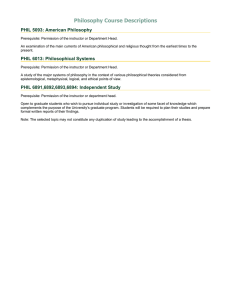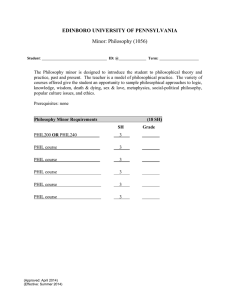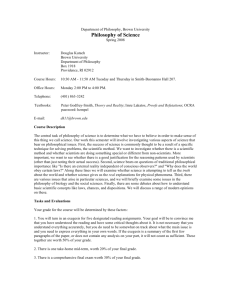MIDDLE TENNESSEE STATE UNIVERSITY General Education Course Assessment Report
advertisement

MIDDLE TENNESSEE STATE UNIVERSITY General Education Course Assessment Report This report is a summary of the activities (assessments and modifications) that have occurred since the course was approved for inclusion in the General Education Program. Please submit the report as an email attachment to the General Education Office at Sheila.Otto@mtsu.edu by March 21, 2014. Course Prefix/Number and Title: PHIL 1030: Introduction to Philosophy Report Prepared by: Professor Mary Magada-Ward, General Education Assessment Coordinator for the Department of Philosophy 1. Review the original General Education course proposal and revise if necessary (for example, a revised course proposal should reflect any changes in course topics, student activities, evaluation procedures, etc.). Explain the rationale for any revisions to the original proposal. If applicable, attach a revised course proposal. No revisions to the course proposal have been found to be necessary. 2. Attach a common course syllabus. If there is no common syllabus (for example, if course syllabi differ across various sections—honors, learning communities, online, larger sections versus smaller sections, themed sections, etc.), provide a brief summary of the variation and attach representative syllabi. Please see section B1 in the attached course proposal (starts on page 3). Representative syllabi are attached as a separate document. 3. Describe how the General Education learning outcomes are assessed and the extent to which students are meeting the outcomes. Include both the process for conducting the assessment and the results. Please see the attached proposal for our embedded assessment procedure (starts on page 7). The only modification to this procedure is a change in generating a random sample. Instead of using a die to determine the last digit of M #’s, we will now use it to determine placement on class roster. (For example, if the die turns up at 6, then we will take every sixth student.) Doing so was found necessary to generate a sample of ten percent for those faculty members who teach fewer than three sections per semester of Introduction to Philosophy. The overall average score for all sections of PHIL 1030 taught in the Spring Semester of 2013 was 22 out of 30. More specifically, the overall average score for learning outcome #1 is 3, for learning outcome #2 is 4, for learning outcome # 3 is 4, for learning outcome #4 is 4, for learning outcome #5 is 3.5, and for learning outcome #6 is 3.5.) We are pleased with this outcome and yet realize that, as elaborated upon below, use of our assessment instrument has proven helpful in our individual efforts at continued pedagogical improvement. 4. Discuss recent and/or planned improvements in curriculum, instruction, and/or student performance in response to assessments of student learning. 1 As noted both in our original course proposal (section B1) and in our proposal for an embedded assessment instrument (section 1), the fact that an Introduction to Philosophy course can be taught in a variety of ways has long been heralded by the academy as one of its strengths. Because of this, the results collected and the concrete recommendations for improvement in meeting our general learning objectives suggested by these results are specific to each of the instructors charged with teaching PHIL 1030. So, for example, one of my colleagues writes that “There is one notable respect in which I think more focused attention should be given, and that is to improve students’ ability to apply classic philosophical positions that have been understood at a theoretical level to the specific cases they discuss and the arguments that they make in their papers. So, I shall attempt to focus more, primarily by working through examples, on getting them to “think” the philosophical principles and concepts less abstractly (so to speak) and so to enable them to show more forcefully how the judgments they make in their papers are supported.” Likewise, a second colleague responds that “As a result of deploying our embedded assessment instrument, I've been enabled to effectively review and evaluate the interchange between students in our online discussion threads, in terms of the relevance and quality of observation, civility of discourse, and willingness to respond directly and appropriately to criticism.” In similar vein, a third colleague reports that “I plan to further expand and vary the offerings of classical philosophical texts so has to continue to deepen students’ understanding of the role of philosophical dialogue in the discourse of humanity.” A fourth colleague writes that "As a result of this process, I've made clearer the standards for assessment with regard to essay exam questions." Finally, I have become more aware of the need to emphasize the historical context of the canonical texts that I cover in my sections of PHIL 1030. 5. Describe the process for overseeing this General Education course. (For example, is there a General Education coordinator or committee? What is the role of the coordinator or committee? Does the coordinator/committee review course syllabi? Is there a process for training new Gen Ed faculty? Is there a mentoring or evaluation process in place for Gen Ed faculty?) Because the Department of Philosophy is marked by its collegiality and because only five tenured faculty members are charged with teaching sections of PHIL 1030 (note, too, that the instructor with the least amount of experience in teaching this course has taught an average of six sections of this course for the past twenty-one years), our process is one of informal meetings and conversation. That is, in my role as assessment coordinator, I check regularly with my colleagues during the course of the semester about pedagogical issues and suggestions for improvement in our approaches to PHIL 1030. (Please see #4 above as well.) Furthermore, because Spring Semester 2013 was our pilot term for implementing our assessment procedure, I have also made sure to determine if changes in procedure were needed. (Please see #3 above.) As of now, therefore, we see no need to institute anything more formal. 6. Identify any additional resources needed to improve teaching and learning in this General Education course. With the recent implementation of our peer tutoring sessions, we do not believe that any additional resources are needed at this time. We do plan, however, to assess the quality and effectiveness of this tutoring in the near future. 2 Course Proposal PHIL 1030: Introduction to Philosophy Course Justification and Outline A. Summary Course Description and Outline 1. Describe the course content and objectives. As its name implies, this course is intended to introduce students to philosophical methods, systems, and problems. In so doing, this course acquaints the student with the history of philosophy and emphasizes its status as a living tradition centrally concerned with the nature of human experience. Moreover, as critical reflection upon human experience, this course is designed to strengthen those habits of self-awareness, responsiveness to alternative points of view, intellectual flexibility, and rigorous, careful analysis so essential to citizens of a democracy. In particular, this course aims to show (1) how and why philosophical methods, systems, and problems are significant features of the cultural legacy of the past and thus how contemporary philosophical activity can fuel cultural transformations in the present and (2) the past and present importance of philosophical study to the project of synthesizing and integrating scientific understanding with cultural values. 2. Describe and justify any special admission and prerequisite requirements for the course. Basic reading and writing ability (i.e., does not require remedial instruction). B. Course Structure 1. Outline of Course Topics Pursued either in historical sequence or by topic, an Introduction to Philosophy course is concerned with those questions that we all, as reflective human beings, have pondered. Such questions include: How should I live? What can I know? What kind of creature am I? What are my responsibilities toward others? Is there a God? In considering such questions and exploring compelling and influential answers to them, an Introduction to Philosophy course shows how and why we find certain ways of addressing these issues provocative and how and why we find certain kinds of answers satisfying. Given the richness and diversity of philosophical activity, which questions are emphasized is at the discretion of the instructor. However, we can provide a general outline of both historical and topical perspectives. When taught from a historical perspective, an Introduction to Philosophy course reveals a dynamic evolutionary past, and the history of that past provides a valuable, if not indispensable, framework for understanding the general history of Western culture – its ideas and their consequences. Typically, required texts will include major works by Plato, Aristotle, Descartes, Hume, and Kant. When taught from a topical perspective, an Introduction to Philosophy course challenges students to examine a wide spectrum of 3 contemporary issues from a critical stance. Typically, such issues will involve the nature and meaning of existence, freedom, doubt, belief, and faith, good and evil, mind and body, and selfhood and community. 2. Student Activities As currently taught, all sections of Introduction to Philosophy require the reading of both primary and secondary sources, completion of essay assignments, the taking of essay exams, and participation in class discussion. Additional activities may include quizzes, class presentations, group projects, electronic discussion, journals, and viewing films. 3. Evaluation Procedures The grade a student in an Introduction to Philosophy course receives is determined by her successfully completing essay assignments and essay exams and by actively participating in class discussion. Such successful completion and participation is, of course, dependent upon the student’s diligence in completing the assigned reading. By requiring competency in both written and oral argumentation and analysis and in reading comprehension, an Introduction to Philosophy course makes a major contribution to MTSU’s General Education Learning Outcomes. Indeed, as will be elaborated upon in the following section of this proposal, Section C, this course fulfills all six of the learning outcomes specified for the Humanities/Fine Arts requirement. C. Contribution to General Education Learning Outcomes 1. Analyze significant primary texts and works of art, ancient, pre-modern, and modern, as forms of cultural and creative expression. All introductory philosophy classes emphasize the close reading and analysis of significant literary texts. These include texts from classical antiquity, the Middle Ages, the modern period, as well as contemporary works. Attention is given to varying interpretations of these texts as well as careful analysis of the arguments presented. 2. Explain the ways in which humanistic and/or artistic expression throughout the ages expresses the culture and values of its time and place. The only way in which the texts referred to above can be carefully read and analyzed is with careful attention to the historical context of each work, Such an historical context necessarily includes religious, scientific, economic, political, and aesthetic dimensions. 3. Explore global/cultural diversity 4 All introductory philosophy classes directly confront issues of diversity. Some of the deepest issues in contemporary epistemology are raised in the confrontation of different cultural and sub cultural groups with each other. In such confrontations students come to better understand the differences amongst these groups. This leads to a confrontation with difficult issues surrounding the nature of reality, truth, knowledge, and morality. At a minimum, attention is given to issues of race, gender, sexual orientation, religion, and economic class. 4. Frame a comparative context through which they can critically assess the ideas, forces, and values that have created the modern world The history of philosophy is the history of an ongoing conversation. In studying any particular intervention in this conversation, students learn how the ideas expressed have helped form the modern mind. Many of these ideas have become part of what we now call common sense. This is true even of ideas that clearly appear to contradict each other. When the contemporary student speaks, he or she speaks in a crude way the language of Plato, Aristotle, Aquinas, Descartes, Locke and many others. In critically examining the history of ideas, the student is forced to critically examine his or her own analytical and critical categories. 5. Recognize the ways in which both change and continuity have affected human history By studying classic philosophical texts in their historical contexts, students come to see major philosophical questions as perennial, while at the same time recognizing the radical reformulations and changing emphases that are part of intellectual history. 6. Practice the critical and analytical methodologies of the Humanities and/or Fine Arts Students, through written and oral assignments, learn to engage in the practice of philosophy. In so doing, they cultivate the analytical skills for reading texts and learn to construct and evaluate complex arguments. In addition, they engage in critical reflection on these analytical and critical practices. D. Course Integrity 1. Estimate the number of sections and seats to be offered in the first academic year after approval. Number of Sections: Fall: 10 - 15; Spring: 10 – 15, Summer: 4 Each section will enroll 40 students. 2. N/A 5 3. Staffing Needs: As in the past, the Department of Philosophy will utilize existing faculty, except in those cases where release time has been granted to a member of the department. Also, and as in the past, release time secured by internal or external grants has been accompanied by money to hire adjuncts. The Department has hired these adjuncts and will continue this practice. 4. Methods of Ensuring Consistency: As indicated in our Self-Study, the members of the Department of Philosophy regularly share pedagogical concerns and strategies both in our scheduled meetings and in informal discussion. As a small, collegial department, we are very familiar with each other’s courses. 5. Since past enrollment did not vary significantly, we do not foresee any significant variation in future enrollment in different sections of this course. 6 Proposal for an Embedded Assessment Instrument for PHIL 1030: Introduction to Philosophy Department of Philosophy, MTSU Coordinators: Drs. Michael Hinz and Mary Magada-Ward (1) Description and Justification As is perhaps widely known, the discipline of Philosophy has never developed any kind of standardized assessment instruments for its courses. Because of this, we propose to construct and implement our own embedded assessment instrument to evaluate how well our sections of Introduction to Philosophy meet the learning objectives of MTSU’s General Education offerings. In so doing, we will be following the lead of other comparable departments of philosophy around the country. Specifically, we propose that each instructor chooses one of his or her completed assignments and then evaluates it according to the rubric which follows. (In essence, such an assignment will be graded twice, once for the student and once for the instructor. This is thus why it is an “embedded” instrument.) We also propose that, at least initially, each instructor evaluates only a random sample of ten percent of those enrolled in the sections of Introduction to Philosophy that he or she teaches each spring. This should provide each of us with a representative sample. On our view, this proposal has at least three distinct advantages over possible alternative methods: (a) Because it has long been recognized that one of the strengths of introductory courses in philosophy is that they can be taught in a variety of ways, any attempt to formulate some sort of multiple choice test that would apply equally well to every section of PHIL 1030 would be, at best, superficial and, at worst, meaningless for any honest and helpful assessment of our contributions to General Education at MTSU. (b) We are convinced that this kind of embedded assessment, which uses work already required of the student, eludes the thorny problem of providing an incentive for the student to take any additional assessment seriously when such assessment has no bearing on the grade that the student will receive in the class. (c) Because each instructor will choose which required assignment to evaluate for assessment purposes, such evaluation should prove sufficiently helpful for each of us in our ongoing efforts to improve the quality of our introductory teaching. 7 (2) Procedure: To generate a random sample, first, calculate the number of students that would comprise 10% of the students enrolled in all sections of Introduction to Philosophy that the instructor teaches during Spring Semester. (For example, two sections of 30 students each would result in 6 assignments to be assessed.) Next, use a die to generate a number between 1 and 6 and then identify students whose last number in their M #’s is that number. (These will thus be the students whose assignments will be subject to embedded assessment.) Finally, evaluate each assignment in terms of the six criteria following and use the instrument itself to report the mean evaluation. 8 (3) Embedded Assessment Instrument for PHIL 1030, Introduction to Philosophy Instructor: ________ Term: ___________ On average, students in this section successfully demonstrated the following: 1. Ability to analyze primary texts. With respect to such texts students can demonstrate the ability to: clearly and accurately articulate philosophical issues, problems, positions or theories expressed in the texts, indicate their philosophical significance, and identify primary concepts and arguments in the texts. (Gen Ed learning outcome #1: Analyze significant primary texts and works of art, ancient, pre-modern, and modern, as forms of cultural and creative expression.) 1 (not adequate), 2 (less than adequate), 3 (adequate), 4 (more than adequate), 5 (beyond expectation) Score: 2. Ability to explain how philosophical works and ideas have reflected, contributed to, and been informed by, the historical and cultural contexts in which they were produced and received. This includes showing an appreciation of how and to what extent religious, economic, political, aesthetic and scientific elements of the society or culture have conditioned, and been conditioned by, philosophical views. (Gen Ed learning outcome #2: Explain the ways in which humanistic and/or artistic expression throughout the ages expresses the culture and values of its time and place.) 1 (not adequate), 2 (less than adequate), 3 (adequate), 4 (more than adequate), 5 (beyond expectation) Score: 3. Awareness of how philosophical writings and views regarding reality, truth, knowledge and morality can, and often do, illuminate as well as obscure the reality and interests of diverse cultural and sub-cultural groups. This includes indicating how issues of race, gender, sexual orientation, religion, economic class, and the like, bear both directly and indirectly on how human beings understand themselves and the world. (Gen Ed learning outcome #3: Explore global/cultural diversity) 9 1 (not adequate), 2 (less than adequate), 3 (adequate), 4 (more than adequate), 5 (beyond expectation) Score: 4. Ability to articulate how the history of philosophy has not only contributed to producing the ideas, principles, forces and values that have shaped the modern world, but also how it exemplifies an ongoing conversation in which earlier and later views critically confront one another and provide alternative viewpoints and bases for understanding how such ideas, principles and forces can be conceived, justified and evaluated. (Gen Ed learning outcome #4: Frame a comparative context through which they can critically assess the ideas, forces, and values that have created the modern world) 1 (not adequate), 2 (less than adequate), 3 (adequate), 4 (more than adequate), 5 (beyond expectation) Score: 5. Recognition that the history of philosophy exemplifies both change and continuity in the development of ideas, an appreciation of different conceptions of change and continuity themselves, how these conceptions have themselves been changed, and how these conceptions influence how change and continuity is to be understood. (Gen Ed learning outcome #5: Recognize the ways in which both change and continuity have affected human history) 1 (not adequate), 2 (less than adequate), 3 (adequate), 4 (more than adequate), 5 (beyond expectation) Score: 6. Competence in thinking according to logical criteria, where oral and written work exhibits the following qualities: well-focused, well-organized, clear, precise, well-argued, sufficiently comprehensive, factually accurate, creatively insightful and imaginative. This includes in addition the ability to perceive internal and external intellectual connections, to form rational criticisms and to assess and resolve difficulties. (Gen Ed learning outcome #6: Practice the critical and analytical methodologies of the Humanities and/or Fine Arts) 10 1 (not adequate), 2 (less than adequate), 3 (adequate), 4 (more than adequate), 5 (beyond expectation) Score: Cumulative Assessment: On average, students in this sample achieved the learning objectives of Humanities and Fine Arts at a rate of ____/30. 11






